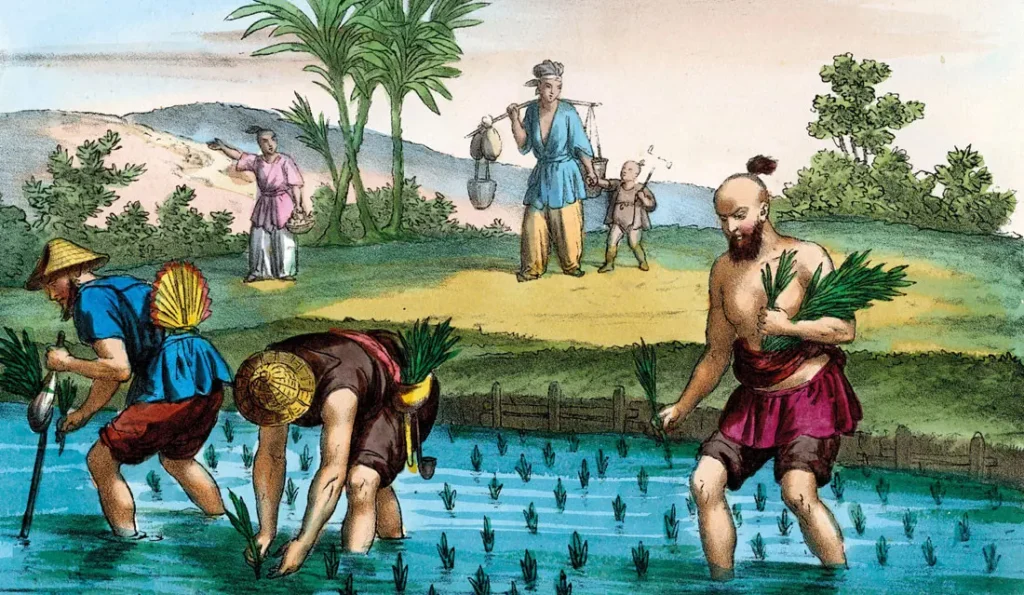
Origin of Rice
Rice is regarded as a first cultivated crop of Asia. Archaeological evidence suggests that rice was being used in the valley of the river Ganges as far back as 6500 BC. Preserved rice grains were found in China around 3000 B.C., while paddy grains found during excavation at Hastinapur (India) around 1000-750 B.C. Southwest Himalayas has various types and varieties and indicated probable centre of origin, though some scientists mentioned south India is its centre of origin. The varietals used suggests that rice cultivation began in the great Asian civilizations in today’s India, China, Thailand and elsewhere almost autonomously. There are altogether 23 species of genus Oryza of which 21 are wild and two viz., Oryza sativa and Oryza glaberrima are cultivated. Oryza sativa is grown in all rice growing areas, but Oryza glaberrima is confined to the West Africa only. Thus it indicates that there might have been two centres of origin of our cultivated rice; South-eastern Asia (India, Myanmar and Thailand) and West Africa.
Rice Etymology:
The Latin word for rice, oryza, and the English “rice” are both derived from the Tamil word arisi. Arab traders took arisi with them and called it al-ruz or arruz in Arabic. This became arroz in Spanish and oriza in Greek. In Italian it is called riso, in French riz, in German Reis. In Sanskrit, paddy is called vrihi. This became vari in Telugu. In Madagascar, on the east coast of Africa, rice is also called vary or vare. In Farsi, the language of Iran, the word brinj is derived from urihi. Kautilya’s Sanskrit treatise the Arthashastra refers to a rice variety shashtik, which took sixty days to ripen. This same rice is now called “saathee“.
Rice in Ancient Culture: History and Folklore of RICE
In Asia rice is an integral part of many cultures folklore. In Myanmar, the Kachins were sent forth from the center of the Earth with rice seeds and were directed to a country where life would be perfect and rice would grow well. In Bali, Lord Vishnu caused the Earth to give birth to rice and the God Indra taught people how to raise it. And in China rice is the gift of animals. Legend says after a disastrous flooding all plants had been destroyed and no food was available. One day a dog ran through the fields to the people with rice seeds hanging from his tail. The people planted the seeds, rice grew and hunger disappeared. All of these stories and many others have rice as their foundation and for generations people have believed these lores of Rice.
Shri-Lakshmi is another Hindu form of the timeless mother goddess who nurtures and nourishes all life. Indians worship rice itself as Lakshmi, the Hindu goddess of wealth or Annapurna, one of her many manifestations. South Indians call rice Anna Lakshmi. Anna means “food” and Lakshmi is the Goddess of prosperity. From ancient times, Dhanya Lakshmi has been depicted holding a few sheaves of rice in her hand. Hindus particularly associate rice with Lakshmi, the goddess of wealth. Paddy stalks or unhusked paddy is worshipped as embodying the goddess, from the sixteenth century till today. Rice and Lakshmi are interchangeable concepts in local imagination.
India is one of the original centers of rice cultivation. For thousands of years this tiny grain has shaped the cultures, economies and environments in this part of the world. The relationship between rice and people has inspired songs, paintings, stories and other modes of communication. Rice is repeatedly mentioned in ancient Indian texts, including the Yajur Veda (compiled in the period circa 1800 BC), and is closely associated with fertility and health across India’s many cultural traditions.
Ramayana – Sri Rama stated to Bharata that special care and attention should be given to the farmers, then only prosperity and happiness of the people could be ensured. There is tale Putrakameshti yagn where agnidev given a bowl of divine Kheer to King Dashrath for distributing among the three queens which results in birth of four sons.
Mahabaratha also stated that agriculture, animal husbandry and trade are the ways of life of the people. It was mentioned that large irrigation tanks have been constructed for agriculture purpose. The tale of Akshay patra and “Tandul (Rice) of Sudama” the poor friend of lord Krishna is famous. Hindu mythology has it that Lord Krishna,was so pleased with his childhood friend Sudama’s gift of two handfuls of roasted rice that in return he gave him the Earth and the Heavens. If his queen, Rukmini, had not stopped him, he would have given Sudama the Cosmos as well.
Parashara was the author of Krishi Parashara, which is regarded as highest authority of agriculture has description of rice. It deals with knowledge and practices relating to agricultural, such as soil classification, land use, manuring, plant protection and agricultural meteorology.
Rice is held sacred by the Buddhists (200 B.C) because when after long meditation, Siddharta’s body became emancipated due to starvation and austerities, it was rice cooked in milk that revived him. Rice plays an important part in Buddhist culture. Gautama Buddha’s father’s name was Shudhodana, which means Pure Rice.
In Punjab earliest mention of word Basmati has been made in the epic “Heer and Ranjha” composed by the famous Punjabi poet Varish Shah in 1766.
The paddy cultivation plays a major role in socio-cultural life of rural India. Because of its basic life-sustaining qualities, rice is revered as a potent symbol of auspiciousness, prosperity and fertility and therefore is used extensively in every religion rites and rituals. It is significant that almost every culture has its own way of eating rice and that these different recipes are part of the world’s cultural heritage.Many festivals such as Onam in Kerala, Sankranthi in Andhra Pradesh, Bihu in Assam, Thai Pongal in Tamil Nadu, MakaraSankranthi in Karnataka, Nabanna in West Bengal celebrates harvest of Paddy. Pongal is an ancient most popular and fervently celebrated festival of Tamils “Pongal” is actually the name of a rice and lentil dish cooked commonly in Tamil Nadu, and specifically on the festive day of Pongal. .
In India, rice is always the first food offered to the babies when they start eating solids or to husband by his new bride, to ensure they will have children. Rice plays a central role in the Hindu (though similar rituals also have other religion) ceremony of annaprashana literally means “feeding rice” in Sanskrit, a ritualized first feeding, as it is the first solid food placed in a baby’s mouth. The most special offering to Lord Ganesha is the modakam, a ball of sweet coconut/jaggery, covered with a thick rice paste, also a first food fed a child. The Vidyarambham (education initiation ceremony) initiates Hindu children into the world of education by exposing them to their first letters. During the ceremony, a child is assisted to form letters in a plate covered with dry rice grains. Rice is utilized in this ceremony as it represents fortune and blessings for the prosperous development of the child. Rice is one among Navadhanyalu at the time of construction of houses (Bhoomipooja) and navagrahapooja. According to Vedic Scriptures, a new Bride brings health prosperity to her new family, from that view a bride pushes a bowl of rice with her feet symbolizing that She is entering a new life with great prosperity- the bowl of rice symbolizing prosperity of life. Kicking a bowl of rice depicts that bride should not have any deficit for food in that house as long as she lives there.Rice is often directly associated with prosperity and fertility, hence there is the custom of throwing rice at newlyweds. Rice, tinted with the auspicious yellow color of turmeric, is showered onto newly-married couples, and is part of numerous rites and celebrations. Raw rice, mixed with kumkum to redden it, is known as mangala akshadai and showered over newlyweds. In Rajasthan, when a fresh married woman first enters her husband’s house, a measure of rice is kept on the threshold. This she scatters through her new home inviting prosperity and happiness. People in Gujarat celebrate Sharad Purnima by soaking flattened rice in sweet milk which they drink at night. Drinking this “dood-powa” on this night is said to protect health.


Very nicely explain History of Rice-word. Good.